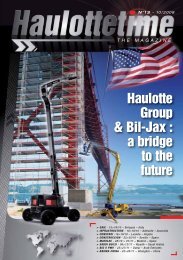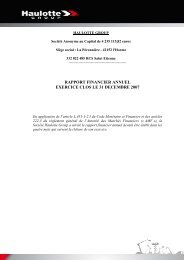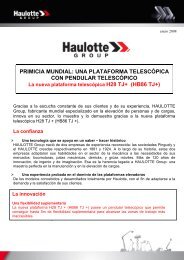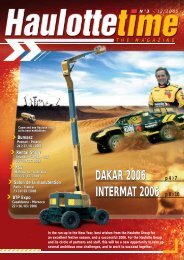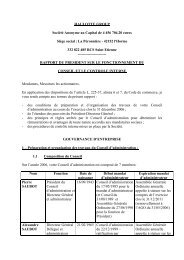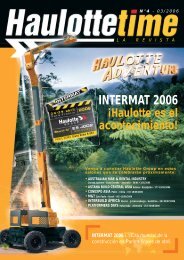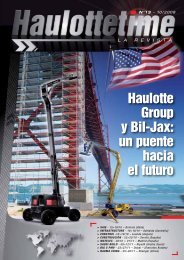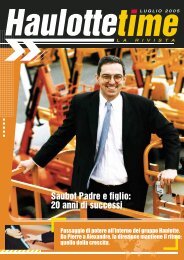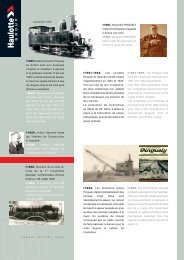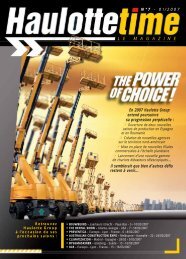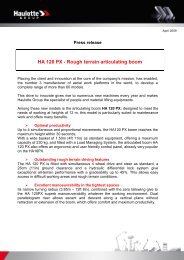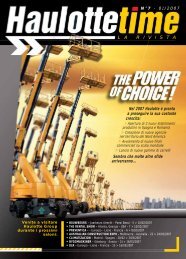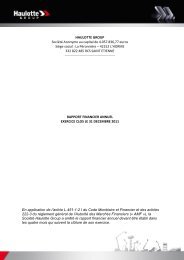2007 - Pinguely Haulotte
2007 - Pinguely Haulotte
2007 - Pinguely Haulotte
Create successful ePaper yourself
Turn your PDF publications into a flip-book with our unique Google optimized e-Paper software.
Consolidated financial statements of December 31st, <strong>2007</strong><br />
3.2 Intangible assets<br />
a) Development expenditures<br />
Research expenditures are expensed as<br />
incurred. Development expenditures in<br />
connection with projects (for the design<br />
of new products or improvement of<br />
existing products) are recognized as<br />
intangible assets when they meet the<br />
following criteria:<br />
- The technical feasibility of completing<br />
the intangible asset;<br />
- The intention of management to<br />
complete the intangible asset;<br />
- The ability to use or sell the intangible<br />
asset;<br />
- That it is probable that the future<br />
economic benefits attributable to the<br />
development expenditure will flow to<br />
the entity;<br />
- The availability of adequate technical,<br />
financial and other resources to<br />
complete the project;<br />
- That the cost of the asset can be<br />
measued reliably.<br />
Other development expenditures that<br />
do not meet these criteria are recognized<br />
as expenses for the period in which there<br />
are incurred. Development expenditures<br />
previously expensed are not recorded<br />
as assets in subsequent periods.<br />
Development expenditures are amortized<br />
from the date the asset is commissioned<br />
on a straight-line basis over the useful life<br />
of the asset i.e. between 2 and 5 years.<br />
In compliance with IAS 36, development<br />
expenditures recognized under assets<br />
not yet fully amortized are subject to<br />
annual impairment tests whenever<br />
events or changes in circumstances<br />
indicate that it might be impaired<br />
(when the inflow of economic benefits<br />
is less than initially anticipated). A<br />
comparaison of the value of capitalized<br />
development expenditures and<br />
expected cash flows projected over a<br />
period between 2 and 5 years is carried<br />
out to determine the impairment to be<br />
recorded.<br />
b) Other intangible assets<br />
Other intangible assets (software, patents,<br />
etc.) are recognized at their purchase<br />
cost excluding incidental expenses and<br />
financial charges.<br />
Software is amortized on a straight-line<br />
basis over 3 to 5 years.<br />
3.3 Property, plant and equipment<br />
Property, plant and equipment are<br />
recognized in the balance sheet at<br />
purchase cost (less discounts and all costs<br />
necessary to bring the asset to working<br />
condition for its intended use) or<br />
production cost. Finance costs are not<br />
included in the cost of fixed assets.<br />
Fixed assets are depreciated according<br />
to their depreciable amount (cost less<br />
the residual value), starting from the date<br />
the asset is ready to be commissioned.<br />
Depreciation is recorded over the useful<br />
life that reflects the consumption of future<br />
economic benefits associated with the<br />
asset that will flow to the enterprise.<br />
When the carrying value of an asset is<br />
greater than the expected recoverable<br />
amount, an impairment is recorded for<br />
the difference.<br />
Component parts are treated as separate<br />
items and subject to different<br />
depreciation rates if the related assets<br />
have different useful lives. The costs of<br />
the renewal or replacement of<br />
components are recognized as distinct<br />
assets and the replaced asset is eliminated.<br />
In compliance with IAS 17, acquisitions<br />
financed leases are recognized as assets<br />
at the lower of fair value of the leased<br />
item and the present value of the<br />
minimum lease payments at the<br />
inception of the lease according to the<br />
procedures defined below when the<br />
lease agreements transfer substantially<br />
all of the risks and rewards of ownership<br />
to the lessee. The corresponding liability<br />
is recognized under borrowings.<br />
Land is not depreciated. Other tangible<br />
fixed assets are depreciated on a straightline<br />
basis over their expected useful lives<br />
as follows :<br />
- Land improvements : 10 years<br />
- Structural work : 30 to 40 years<br />
- Interior office improvements :<br />
5 to 10 years<br />
- Paint line : 8 to 15 years<br />
- Telehandlers, aerial work platforms<br />
and cranes : 7 to 10 years<br />
- Machine tools : 20 years<br />
- Other equipment : 10 years<br />
- Industrial processes : 3 to 5 years<br />
- Computer equipment : 5 years<br />
- Furniture : 10 years<br />
- General services : 20 years<br />
The residual value and useful lives of the<br />
assets are reviewed and when necessary<br />
adjusted at the end of each period.<br />
3.4 Treasury shares<br />
Shares of <strong>Haulotte</strong> Group S.A. acquired<br />
in connection with the Group share buyback<br />
programs (liquidity contract assuring<br />
an orderly market in the company’s shares<br />
and buyback program) are recorded as<br />
a deduction from equity at acquisition<br />
cost. No gain or loss is recognized in the<br />
income statement from purchases, sales<br />
or impairment of treasury shares.<br />
3.5 Financial assets<br />
Financial assets includes loans, advances<br />
to non-consolidated subsidiaries and<br />
other financial assets recognized at fair<br />
value on the acquisition date and<br />
measured at amortized cost at the end<br />
of each period. Any impairment in the<br />
value of these assets is immediately<br />
recorded in the income statement.<br />
The classification and designation of<br />
financial assets is determinated at initial<br />
recognition, when the Group becomes<br />
a party to the contractual clauses<br />
of the assets and are subject to reevaluation<br />
at the end of each period in<br />
accordance with IAS 39.<br />
ENGLISH



